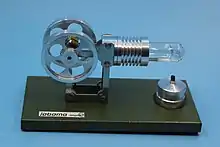

The Manson engine is a hot air engine that was first described by A. D. Manson in the March 1952 issue of Newnes Practical Mechanics-Magazines.[1] Manson Engines can be started both ways (clockwise and anti-clockwise).[2] It has a stepped piston. The front part is acting as a displacer and the back part as work piston (displacer and piston move as a single component).[3][1] The engine only requires three moving parts (piston,[3] piston rod and crank).
The engine is double acting,[1] as it is using both the expansion of the warmed air and the contraction of cooling air to exploit work.[3][4][5]
The engine has no commercial or practical application. The engines are built mainly as desk toys, physics demonstrations, and novelties.[2]
Functioning mechanism

- Phase 1 (cooling down the work medium, suction stroke)
- when the Piston is moved towards the heat source, the hot gas inside the engine is moved to the cool side of the cylinder.
- the gas is cooled there, resulting in a drop in pressure, further moving the piston towards the heat source.
- Phase 2 (top dead centre)
- When the piston reaches top dead centre, the inlet valve is open, releasing the vacuum.
- the flywheel keeps the piston moving
- Phase 3 (heating up the work medium, expansion stroke)
- when the piston is moving away from the heat source, the air is pushed towards the heat source.
- the air is then heating up, resulting in the air expanding and the piston being further pushed away from the heat source
- Phase 4 (bottom dead centre)
- when the piston reaches bottom dead centre, the exhaust valve is open, releasing the build up pressure and hot air.
- the flywheel keeps the piston moving
Differences to Stirling engines
Stirling engines are typically closed systems, while the Manson Engines are open system.[3][5][8][2] The displacer and work piston of the Manson Engine have zero phase angle.[4]
Variations

The valve/gas paths are considered by some to be complicated to manufacture, so various variants exists with improved/modified simplified vales/gas paths.[9][10]
Sources
- 1 2 3 4 "The Manson experimental double acting engine". www.stirlingengines.org.uk.
- 1 2 3 "Nano Disc - Horizontal - From www.stirlingengine.co.uk". Stirlingengine.co.uk.
- 1 2 3 4 "Manson". techref.massmind.org.
- 1 2 "New generation of hot air engines: Manson engine".
- 1 2 "Manson". www.geocities.ws.
- ↑ "Principes de fonctionnement du moteur Manson". December 22, 2018. Archived from the original on 2018-12-22.
- ↑ "Manson-Motor". www.w-haag.de.
- ↑ https://journeymans-workshop.uk/images/downloads/manson.pdf
- 1 2 C2 DE 19904269 C2, Michael Ruppel, "Heißluftmotor - Heat engine has a simplified design with combined piston and valve and with alternate sides of the piston vented in either limits of the piston movement", published 2000-11-9, issued 2001-6-5
- ↑ GB application 2554458A, Christopher Guise, "Improvement to Manson engine", published 2000-11-09
